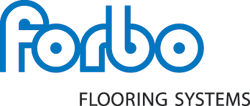The Significance of Entry Flooring Systems
Installation, Cleaning and Maintenance
A high-quality installation is of utmost importance for a trouble free and durable lifetime expectancy of the flooring material. Since so many things about entrance flooring systems are custom and may vary between manufacturers, it is important to consult the instructions, recommendations, and directions from those manufacturers regarding proper installation, cleaning and maintenance. Nonetheless, there are a number of common points to be aware of and include in specifications.
Textile systems will generally be installed like most carpet systems requiring the usual subfloor preparation and installation using a glue-down or other method of attachment. If necessary, the subfloor may be leveled with a cement based leveling compound. The subfloor should be smooth, rigid, clean and permanently dry. Lay out the acclimatized material (at least 60 degrees F) on a smooth horizontal surface and allow it to relax at recommended temperature and time before precutting it. Cut off the edges leaving 3/8-in. extra on each side before a butt jointed installation.
Carefully follow the instructions provided by the supplier of the adhesive. Acrylic adhesives usually are evenly applied to the substrate only. A waiting time should be considered before the flooring is placed and pressed into the adhesive. Usually this is achieved when the adhesive shows “tackiness” at normal conditions (room temperature, average moisture), typically after. 10 minutes of installation. After laying the textile material in the adhesive bed use a (hand) roller to improve firm adhesion.
Pressure sensitive adhesive (contact adhesive) is applied to both the substrate and the flooring material, usually with a texture roller to obtain a maximum adhesive surface area. Be aware that pressure sensitive adhesives require an extended drying time before the materials can be attached, especially the water based types. Check the producer's instructions to find out detailed information. Transition strips to make transitions between the entrance floor and other types of floor coverings, such as resilient or carpet floors may be needed and should be specified accordingly. These strips are commonly available in a palette of colors that match the colors of manufacturer's flooring collections.
Rigid grid mats will require coordination with the concrete work to be sure that the recessed well is properly located and sized according to the design intent. The local installer will need to field measure and verify the size of the concrete recess to be sure the custom sized grid mats will fit properly. The perimeter frame is then installed and the single or double sided rigid grid mats are laid in place.
Once installed, the entrance floor systems will begin doing their job and start removing and retaining dirt and moisture. That means they will need to be cleaned to allow that dirt and moisture to be released as intended. It is essential to remove dry soiling at least once a day. The most effective method is to use vacuum cleaners that incorporate a mechanically driven rotating brush or suction-only machines with a rotating brush attachment. Vacuum slowly and in all directions across the matting, to get the full effect of the combined suction and brushing.
High-traffic areas may need additional attention to remove concentrated surface soiling and reduce the appearance of “traffic lanes.” This can be done using a dry extraction method that uses a moist compound impregnated with water, detergent and safe-to-use solvents. Alternatively, a cylindrical brush extraction method can be used. This approach uses machines with counter-rotating brushes, but this time a recommended carpet cleaning solution is brushed into the pile and the dirty water returned straight to the machine.
As with all flooring systems, any spills or spot producing items should be cleaned up right away. Gently clear away the spillage from the surface with a blunt scraper. Treat what is left of the spillage with a recommended carpet spot cleaner, rinse with clean water, and allow the surface to dry.
At regularly scheduled intervals, the matting should be treated with a deeper cleaning process called “spray extraction.” This removes soiling from the base of the pile and restores the surface texture to optimize its “clean-off” performance. Factors like the type and amount of traffic, as well as the effectiveness of daily and regular cleaning routines will govern how often this deep cleaning is needed. This process can be carried out using either a spray extraction machine or a 3-in-1 spray and brush machine. When wet cleaning is not possible a powder cleaning is the best solution.
This combination of daily vacuuming, regular washing and deep cleaning will keep the entrance flooring systems in optimum condition to function properly and look good for years to come.
Conclusion
Including an entrance flooring system in buildings with pedestrian and wheeled traffic yields many benefits to the owners and users of that building. Reduced maintenance costs, reduced chance of slipping and falling, cleaner indoor environments, and great appearances are among the reasons to include them. Designing complete systems that address the four R's of removal, retainage, release and recovery in each of the common entry zones of a building assure a comprehensive design. Finally, specifying the appropriate details for either a textile mat or rigid grid system or both will maximize and optimize both function and appearance. When designed, specified and installed properly, architects, owners and building occupants all benefit from the proper attention to this very active portion of a building—entrances.
 |
Forbo Flooring Systems is the global market leader in linoleum floor coverings, with Marmoleum owning a market share of over 60%. Forbo also produces high-quality vinyl and resilient textile floor coverings and entrance system solutions. Forbo is committed to environmentally responsible production and to far-reaching customer service. www.forboflooringna.com |








